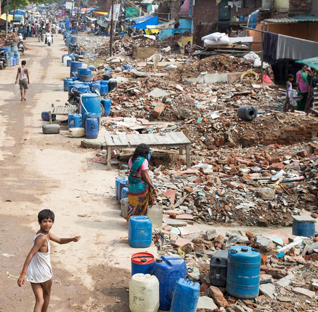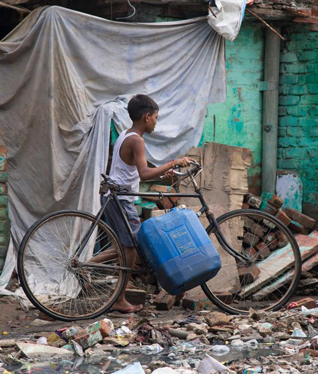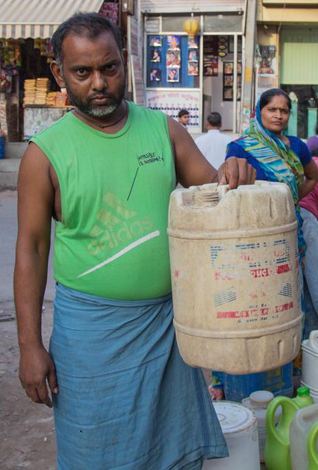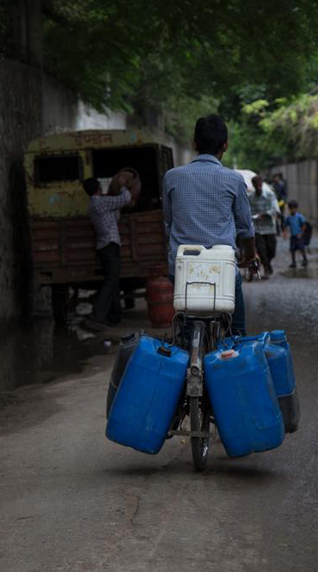Current Events
The Water Mafia of India
BABA TAMIM
New Delhi, India
For Vishal Agnihotri, 33, a rickshaw puller in the Dwarka neighbourhood here in the capital of a country which spends a billion dollars around the world branding itself "Incredible!" and "Shining!" India, the Global Water Week that kicked off yesterday (Sunday, August 31, 2014) in Sweden and the ice bucket challenge craze mean nothing.
"I haven't had a bath for the last four days. We don't have water for drinking; forget taking a bath in ice cold water," he says.
New Delhi, a region ruled directly by the federal government as a 'union territory' and the nation's flagship city, became the world's second most populous city this year after Tokyo, more than doubling its population since 1990 to 25 million, according to the latest UN report. The city is expected to retain this spot until 2030, when its population is expected to rise swiftly to 36 million, the report says.
But does the city have enough drinking water for its bulging population?
Currently the demand for potable water is around 1,100 mgd (million gallons per day) but the government only supplies around 800 mgd. About 81 percent of the households get piped water. The rest of the population relies on mobile water tankers.
Last year the Delhi government even had to insist that 35 five-star hotels cut down their consumption.
With no ensured timely distribution of water to the inhabitants at many places, the water mafia has taken over.
"Government is the biggest problem. It doesn't plan water resources," says Himanshu Thakkar, coordinator with the New Delhi-based South Asia Network on Dams, Rivers and People.
That's why in this water-hungry city, a parallel water industry is flourishing despite tough measures taken by the Delhi Jal Board (DJB) which is responsible for maintaining Delhi's water supply.
"The water mafia will work when there is a scarcity of water. It's because of the unequal distribution of the water by the authorities. People who need water anyways see a solution in water tankers," explains Dewan Singh, an environmentalist at Natural Heritage First.
It's estimated that more than 2,000 private tankers draw water from tube wells and the DJB connection and sell the water to residential localities and industries at exorbitant rates. This industry earns an estimated Rs. 4 billion ($66.15 million) annually.
Water tanker rates differ on the basis of capacity, season and demand, and in some cases, the customer.
Almost half of Delhi's population lives in slums where getting water is a challenge every day.
[Courtesy: Al Jazeera. Edited for sikhchic.com]
September 1, 2014
Conversation about this article
1: Kaala Singh (Punjab), September 01, 2014, 2:30 PM.
Wow, an incredibly shining country! This is the city that massacred its creators, the Sikhs. Just you wait and watch what happens to this city in the times to come, you are already beginning to see it. Your Sajjan Kumars, Tytlers and Bhagats won't be able to help you guys!
2: Kanwarjeet Singh (USA), September 02, 2014, 12:02 AM.
Heaven and hell are all on earth and one gets paid for one's deeds in this life, contrary to what many may say. In fact the earlier you get paid back for your misdeeds the lesser the 'interest' on it. As Kaala Singh ji pointed out, the ghosts of 1984 will make this city and country suffer ...
3: Kulvinder JIt Kaur (Niagara Falls, Ontario, Canada), September 03, 2014, 7:31 AM.
Readers, please check out the book, 'Blue Gold' by Maude Barlow and/or watch the documentary by the same name (Blue Gold, 2008). They are eye-openers to the fast approaching world crisis in water shortage. We are using up (mostly wasting) fresh water at a rate which will soon endanger water supply as we know enjoy. The vice president of the World Bank had already declared at the end of the 20th century" "... the wars of the next century will be about water..." Just as we are now fighting over oil, the time is not far when the control over water will be the cause of wars. Luckily, we in Canada have 7% of the world's renewable fresh water and 23% of fresh water (non renewable) but even we, with such a small population, are quickly polluting our waters and making them undrinkable. India, China and Sub-Saharan Africa are already suffering the effects and it won't be long before it reaches our door step. Something to think about seriously.






